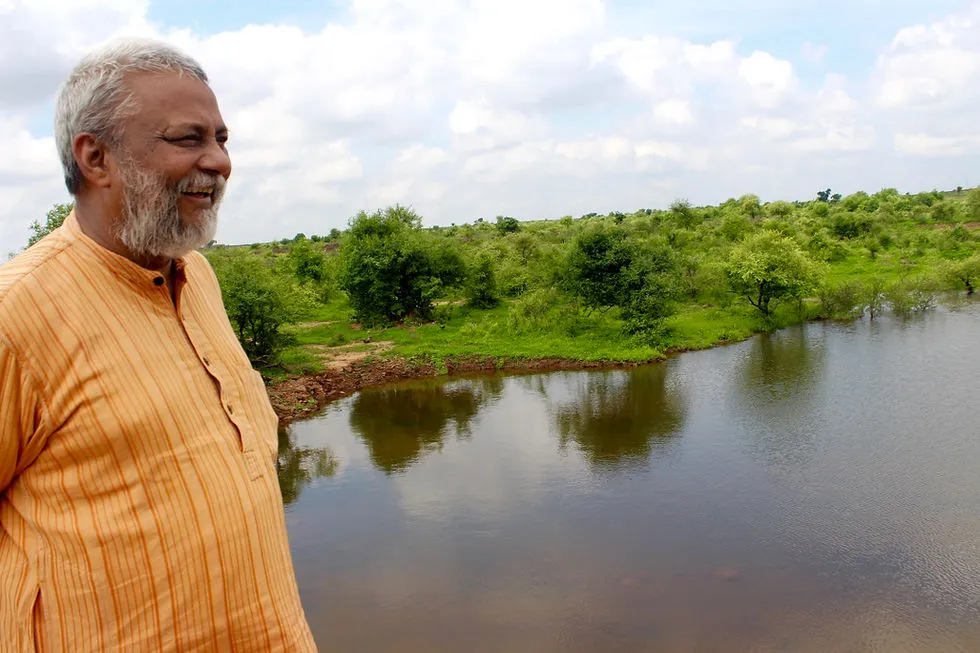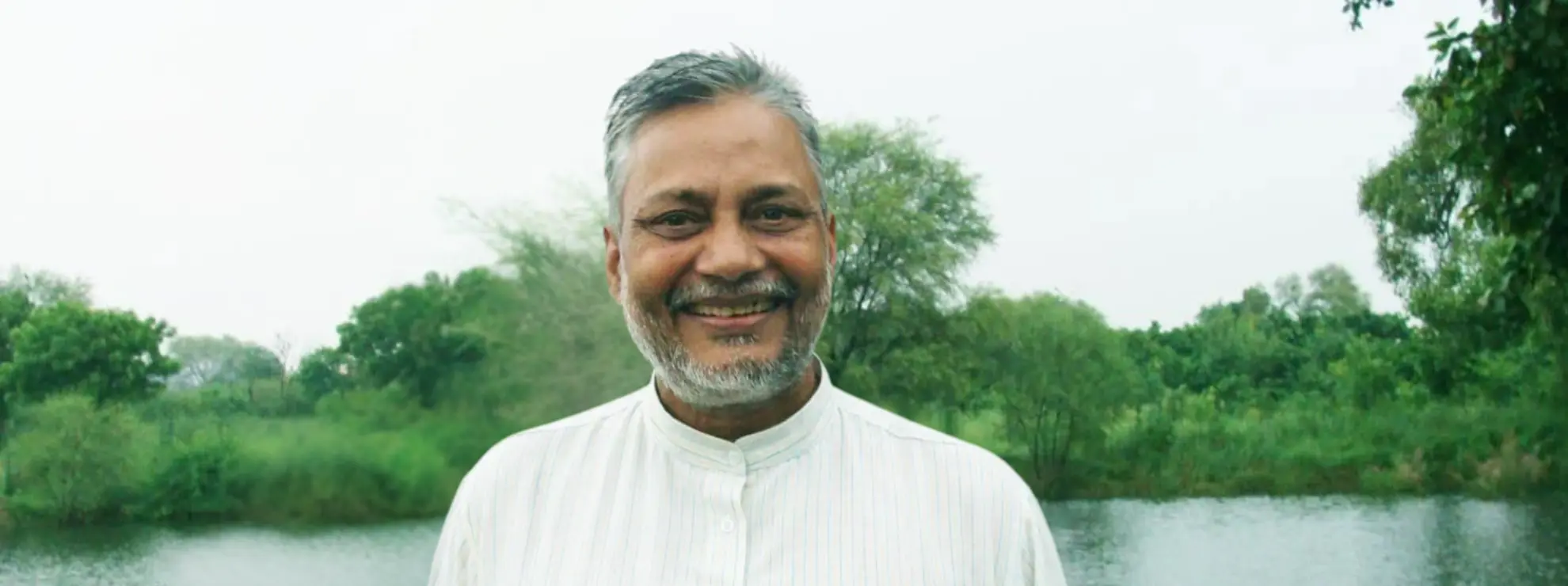(December 24, 2024) In the 1980s, the inhabitants of Gopalpura, a village in Rajasthan, were suffering from a disease they called ‘rathondi’, or night blindness. In 1985, Rajendra Singh, an Ayurvedic doctor and the founder of an NGO named Tarun Bharat Sangh arrived there to provide medicine to the locals. He noticed that the underserved community needed education. so decided to start a school and settled into the village for seven months to continue his work on medicine and education.
One day, a farmer came up to him and said, “We don’t need medicine, we don’t need education. We need water.” From the old farmer, Singh learned how to build johads—traditional earthen dams that are surrounded by an embankment. It brought instant results—one monsoon revived the wells, the underground aquifers, recharged the small springs, and rejuvenated a dying community with it.
Founded in 1975, Tarun Bharat Sangh, in its mission to bring water and revive India’s remote rural pockets, has fought the slow bureaucracy, hostile governments and even the mining lobby to help villagers take charge of water management near their homes. What started with a small village in 1985 grew into 8600 johads and water conservation structures that have brought water to over 1000 villages and revived several rivers. The Global Indian, who is known as the ‘Waterman of India’, won the Magsaysay Award in 2001 and the Stockholm Water Prize in 2015. “All we had to do was recharge underground aquifers. As this type of work spread to other villages and states, 12 rivers were revived,” he said in an interview.
The Gandhian influence
Rajendra Singh was born in a small village near Meerut, in Uttar Pradesh. He was the oldest of seven siblings and his father looked after 60 acres of land in Daula village. In 1974, when Singh was a teenager, a member of the Gandhi Peace Foundation visited the family home. He spoke about issues of village improvement and went about cleaning the village, opened a library, and even helped settle local conflicts.
The young Singh watched in admiration and soon got himself involved in an alcoholist eradication program. Another major influence was an English teacher in his school, Pratap Singh, who would discuss politics and social issues with his students after class. In 1975, the same year as the Emergency, when a new surge of activism and protest spread through the country. Singh and a group of his friends and professors from the University of Rajasthan founded Tarun Bharat Sangh.
The journey to Alwar
In 1985, members of TBS made their way to Rajasthan’s Alwar district, where Singh had his fateful meeting with ‘Mangu kaaka’, the farmer from Gopalpura. Apart from being malnourished and underserved in every way, the intra-communal animosity over water grew and had been stoked by politicians with an agenda. Singh could see the wisdom in the old farmer’s words and decided to take charge of bringing water to the village.
“My entire training on water took all of two days. Mangu kaka took me to 25 dry wells in the village and made me climb down 80 to 150 feet, to see the belly of the earth. I looked at the different types of fractures in the wells and understood how we can save water from being stolen by the sun,” Singh told idr in an interview. In Gopalpura, where temperatures could soar as high as 50 degrees Celsius in the peak of the long, brutal summers, ground water that bubbled to the surface would evaporate instantly. The traditional method to trap it and recharge the water table was the johad, a small, earthen dam surrounded by an embankment.

Rajendra Singh, the Waterman of India
The return to traditional water conservation methods undid years of damage caused by deforestation and mining, as well as the reliance on borewells, which had pushed the groundwater table further down each time. “After just one monsoon, the wells and underground aquifers started getting recharged. That water in turn rejuvenated the small springs that had dried up. All we had to do was recharge underground aquifers,” Singh said. When water came back to the village, so did the young people who had left home in search of work. The recharged groundwater tables led to increased forest cover, which in turn brought the rain.
“I started three types of yatras,” Singh explained. They were Jal Bachao Johad Banao (save water), Gram Swavalamban (self reliance) and Ped Lagao Ped Bachao (plant trees). Word spread to nearby villages and in 1986, Rajendra Singh began his first Padayatra through the villages of Alwar district. “We built almost 9000 johads and other conservation structures for collecting rainwater to use in the dry season,” Singh told Lifegate in an interview. Nearly two million people were impacted, and tens of thousands of jobs were created, he explained.
Taking on the mining industry
In 1986, Rajendra Singh joined the people of Bhanota-Kolyala village and along with TBS volunteers, constructed a johad at the source of the Arvari river, which had gone dry. After 60 years, water began to flow again in 1990. However, even after constructing numerous johads along the river and its catchment areas, the water level wasn’t rising as expected. The problem was in mining pits that had been left unfilled by the miners in the area.
Rajendra Singh took the mining companies to court by filing a PIL in the Supreme Court. In 1991, the court banned mining in the Aravallis. One year later, the Ministry of Environment and Forests banned mining in the Aravalli hill region altogether and 470 mines were shut down. TBS continued its work, building 115 earthen and concrete structures and by 1995, the Aravri was a perennial river. Singh went on to rejuvenate other rivers – Ruparel, Sarsa, Bhagani and Jahajwali. Abandoned villages in the areas were repopulated and farming was resumed in hundreds of villages that had once been prone to drought.
Challenges
One of the biggest challenges, Singh says, was from the government. “At Gopalpura, the irrigation department tried to impose restrictions saying we were blocking ‘their’ water. Now, if the rain falls over someone’s farm, who does that water belong to/ The farmer or the dam? I told them, if the rain falling on the farmland doesn’t belong to the farmer, you should stop the rain, let there be no rain in the village,” Singh said. Their slogan was “khet ka paani khet mein, gaon ka paani gaon mein” (a farmland’s water stays on the farmland, a village’s water stays in the village). The problem, Singh feels, was that they were constructing dams at little to no cost. On the other hand, the government was creating budgets for hundreds of crores and hiring contractors. “What they were scared of was their corruption getting exposed.”
What the government can do, he says, is “everything.” “It can use the INR 70,000 crore in the MGNREGA to provide work to those who have returned to villages and create infrastructure for water conservation,” he says. People in cities, believes Singh, needs to understand that the water in their taps comes from villages.
International recognition
Rajendra Singh’s commitment to water conservation has garnered international recognition, including the Ramon Magsaysay Award in 2001 and the Stockholm Water Prize in 2015. In November 2024, Singh was appointed as a Professor of Practice at Anant National University (ANU) in Ahmedabad. In this role, he mentors students through real-world, on-ground projects that foster community engagement and problem-solving skills. He also chairs the Centre for Indigenous Knowledge Systems and Practices at the university.
Singh’s influence extends beyond India. His water conservation techniques have been adopted in over 15 countries, including Egypt, Kenya, and Somalia, where communities have implemented water harvesting and conservation programs under his guidance.
Water as a human right is only possible after river rights and nature rights. Without the clean flow of the river you can’t ensure the human right. – Rajendra Singh, The Waterman of India
Despite facing challenges from government authorities and the mining industry, Singh’s unwavering dedication has led to the creation of over 15,800 water bodies and the rejuvenation of 23 rivers across various states in India. His work has transformed drought-prone areas into fertile, green landscapes, providing livelihoods for millions and setting a global example for sustainable water management.
Singh’s journey from an Ayurvedic doctor to the ‘Waterman of India’ exemplifies the profound impact one individual can have on environmental conservation and community empowerment. Rajendra Singh’s work continues to inspire efforts toward sustainable water management worldwide.





